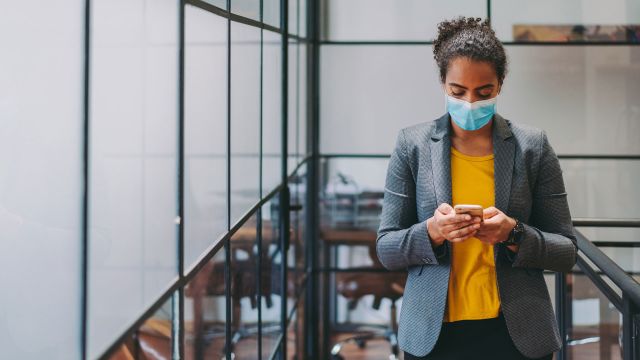Updated on June 26, 2020.
Americans are increasingly returning to the workplace, whether they want to or not. For some employees, furloughs have come to an end. Others may face termination if they don’t show up. Many are worried about their financial situation.
But with COVID-19 continuing to spread in areas around the country, a significant proportion of workers worry about being infected on the job. In one late-May poll of about 1,900 adults, nearly half said they feared possible exposure at their place of business.
“They are now working around many colleagues who could potentially spread the virus,” says John Dooney, HR Knowledge Advisor for the Society for Human Resource Management. “Many employees are concerned about coming home from work and transmitting the virus to family members.”
A great number of employers take the risk of exposure seriously. They’re obeying state and local orders to safeguard staff from disease. They’re also following recommendations from the Centers for Disease Control and Prevention (CDC) and the Occupational Health and Safety Administration (OSHA), such as increasing cleaning frequency and limiting face-to-face interaction.
Still, even with preventive steps, no company can guarantee a COVID-19-free workplace.
So, what steps can you take on the job to guard yourself from infection? How does your human resources (HR) department help create a safer workspace? And if your employer hasn’t done enough to protect personnel, what are your options, legal and otherwise?
Things to know before you go back
First and foremost, it’s crucial to understand that the U.S. remains in the thick of the pandemic. As a result, workplace safety policies and recommendations are changing frequently—sometimes from day to day. It’s likely they will continue to shift in the coming months, too, as the pandemic evolves.
It’s also important to know that the rules aren’t the same for everyone. Preventive measures taken by your employer will depend largely on your workplace—and crucially, your location. Some states and local governments have ordered certain businesses to adopt specific safety precautions, while others have not.
“It varies from state to state, sometimes from city to city,” says Charles Sullivan, professor of law at Seton Hall University Law School in Newark, New Jersey.
Both the CDC and OSHA have published extensive guidelines for safe workplace reopenings—but these are recommendations, not laws. They cannot be enforced. While it’s good practice for an employer to adopt the agencies’ suggested measures, failing to do so isn’t illegal.
Take personal precautions
As a general rule, upon returning to work, you should follow all safety procedures and policies put forth by management. Face coverings or personal protective equipment (PPE) could be required and you may have your temperature taken daily upon entering your office. Meetings might be conducted via phone or video chat. Desks or workstations will possibly be spaced further apart, and break areas and conference rooms may be closed. Social distancing will likely be encouraged.
Above all, handwashing remains a vital measure for preventing COVID-19 infection. Remember to wash up before and after meals or whenever you leave shared spaces within your office, as well as whenever you cough, sneeze, handle your mask or use the restroom. If your commute involves public transportation or if you need to run out of your office midday, clean your hands right away when you arrive back at work. Don’t touch your eyes, nose or mouth until you wash up.
Get into the habit of routinely cleaning and disinfecting your workspace, too. While your office may be scrubbed more thoroughly and regularly than it used to be, high-touch surfaces like keyboards and phones can use extra attention. When possible, avoid sharing items with coworkers. If you need to use the same supplies, clean and disinfect them afterwards.
Be sure to cover your mouth and nose when you sneeze or cough, and dispose of used tissues in trash cans. Should you develop possible symptoms at work, let your supervisor know right away. You should be separated from coworkers and sent home to follow up with your healthcare provider. Management will then inform your colleagues about possible COVID-19 exposure.
Most importantly, if you or someone you live with is ill, alert your manager and stay home.
For workers in high-risk groups
What if you have a chronic health condition that increases your risk of serious COVID-19 complications, such as diabetes or heart disease?
“If an employee is high medical risk due to a pre-existing condition or other reason, they may want to ask their manager or HR for an accommodation under the Americans with Disabilities Act (ADA),” says Dooney. An HR specialist can help guide you through the process, he explains.
Accommodations must be reasonable for the employer to meet and will depend on the disability itself. They may include steps like allowing for telework or minimizing tasks that put the employee in contact with colleagues.
Not every health issue may qualify for an ADA accommodation, but Sullivan points out that management may want to avoid getting too picky during the pandemic. “Employers would be well-advised to take a broad view of what counts as a disability, and not get into the weeds as to whether a particular condition counts,” he says.
He also notes that there are two things workers should know about ADA accommodations. “First of all, it’s limited to the employee's own condition,” he explains. “So, if you're living with an immunocompromised spouse or child, and you don't want to put them in danger, that doesn't make you disabled under the ADA.”
Some employees in this situation may want to explore the Family and Medical Leave Act, which allows for up to 12 weeks of unpaid leave if you have a serious health condition or need to care for a sick family member. Another law, the Families First Coronavirus Response Act (FFCRA), provides additional protections for workers and family members who specifically become ill with COVID-19.
The second thing to know about the ADA: Though advanced age is considered a risk factor for serious COVID-19 complications, it may not qualify you for accommodations. “Obviously getting older is frequently accompanied by the things that would be counted as a disability, but age by itself is not a disability,” Sullivan explains.
If you’re an older adult returning to the office, however, it can’t hurt to ask your manager for certain adjustments to be made. Employers can provide flexibility to senior workers that they don’t for younger employees, according to the Age Discrimination in Employment Act.
How human resources can help
Your employer may be doing all the right things: following best practices, being open and direct about pandemic-related changes and working with staff to create a supportive environment.
Still, after months spent in lockdown, you and your colleagues may feel anxious about resuming job duties, adapting to a transformed workplace and protecting yourselves from virus exposure. Even being around each other again can be nerve-wracking.
Dooney says this is where HR can help. Regarding mental health challenges, “HR may be able to provide counselors to help employees address stress in the workplace,” he explains. “They may even contract with an employee assistance program so that employees can seek counseling.”
The HR department can also act as a channel for employees to voice concerns and provide you with information about key company policies. For example, the FFCRA requires certain businesses to have a flexible pandemic sick leave policy in place. This may include allowing workers to stay home with ill family members, and not penalizing them if they do. If you have questions about your job’s leave policy—or any COVID-19 policy—HR should have answers.
Legal protections for workers
OSHA requires employers to provide a safe and healthy workplace. Upon going back to work, some people may feel their employer isn’t doing enough to mitigate exposure to COVID-19. If you can provide examples that your job puts you at risk for contracting the illness, you may want to file a confidential complaint with OSHA and ask for an inspection. More than 5,000 workers have done so since the start of the pandemic.
“You can't be fired for filing the complaint,” says Sullivan. “But OSHA does not give you a right not to show up for work.”
In some cases, you could lose your job if you decide to stay home. Federal laws like the Occupational Safety and Health Act and the Labor Management Relations Act may offer some protection if a workplace plainly threatens your wellbeing. But cases could be hard to prove, especially if an employer has taken preventive measures.
Additional legal protections depend largely on where you live. Some states have strong existing laws to safeguard workers, and some expanded protections after the pandemic started. Check with your own state’s health department or attorney general’s office for more information.
You can also consult a lawyer to learn more. “We're talking about life and death on the one hand versus livelihood on the other,” says Sullivan. “So, I think you should be well-informed in that circumstance.”
Two additional things to keep in mind: Simply being worried about infection is generally not a good justification to stay home. Resigning is risky, too, since quitting may prevent you from qualifying for unemployment. Again, the rules differ among states; consult a legal expert for guidance.
The bottom line
Ideally, employers should take the necessary preventive measures to keep staff safe. But even if they do everything right, being exposed to COVID-19 remains a possibility. You can help protect yourself and your loved ones by implementing your own good practices, working with management to create a safer workplace, knowing your rights and asking for legal help if necessary.





